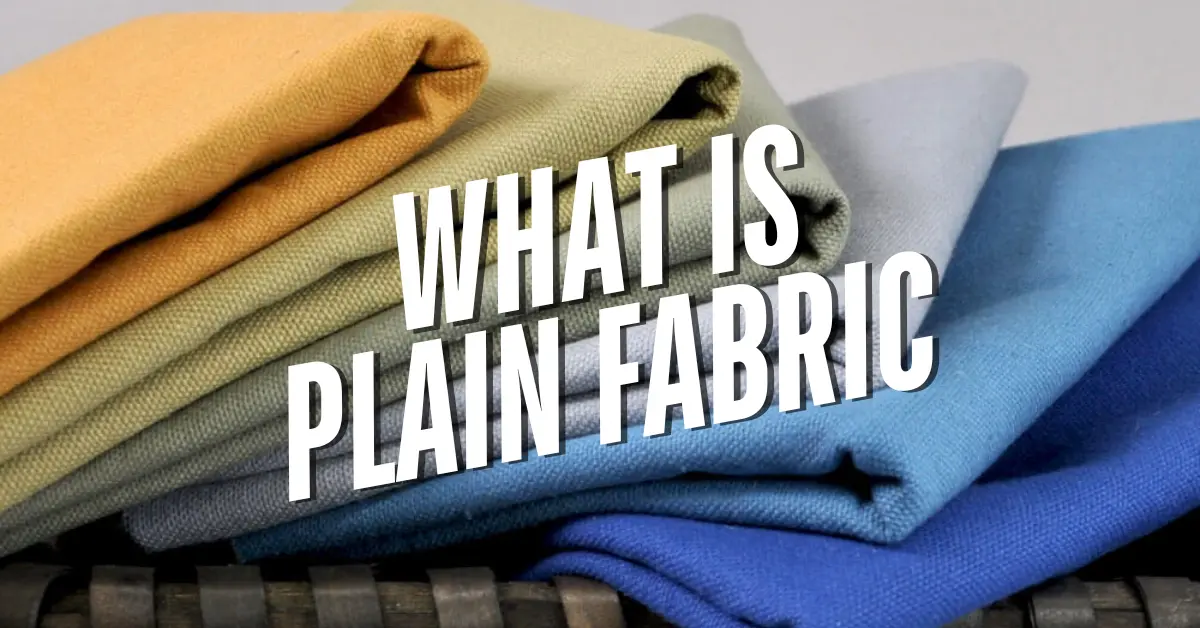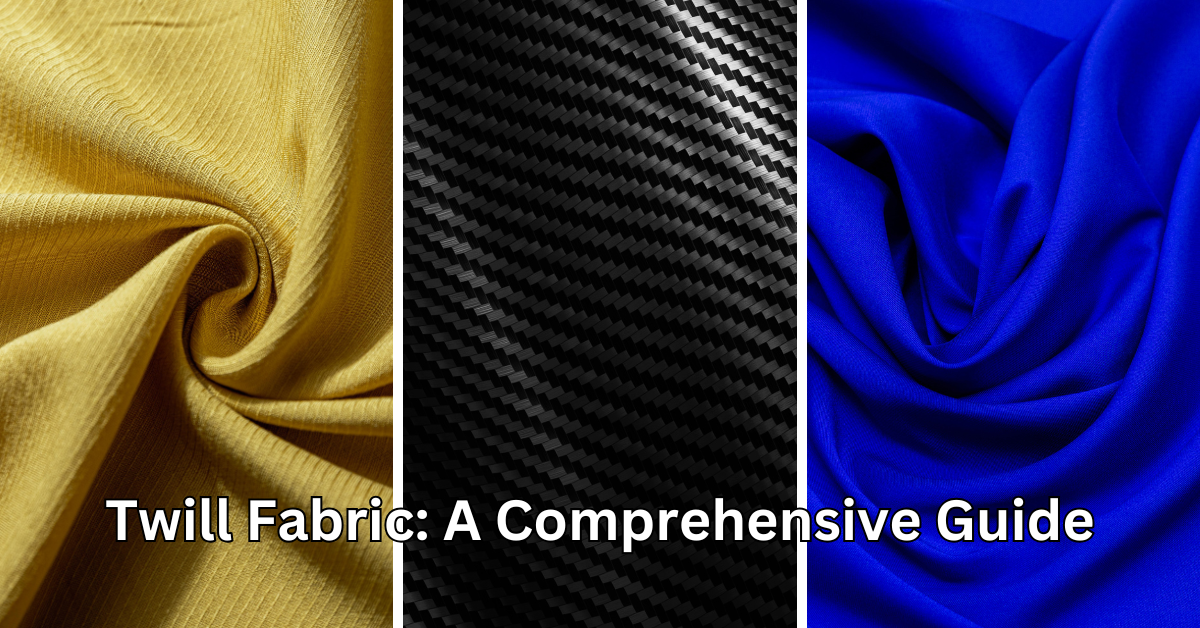Twill fabric is a popular textile known for its durability, flexibility, and unique diagonal weave. It is widely used in clothing, upholstery, and industrial applications. This article explores different twill fabric names, their characteristics, and common uses.
What is Twill Weave?
Twill weave is a basic textile pattern where the weft thread passes over and under multiple warp threads, creating a distinct diagonal pattern. This structure makes twill fabrics stronger and more resistant to wrinkles than plain weaves. Twill fabrics also have a softer drape, making them ideal for various applications.
History and Evolution of Twill Fabrics
Twill fabrics date back thousands of years, with early examples found in ancient China and Egypt. Over time, twill weaving techniques evolved, leading to the development of various fabric types suited for different climates and applications. From medieval woolen garments to modern denim jeans, twill remains a staple in the textile industry.
Popular Types of Twill Fabric Names and Their Applications
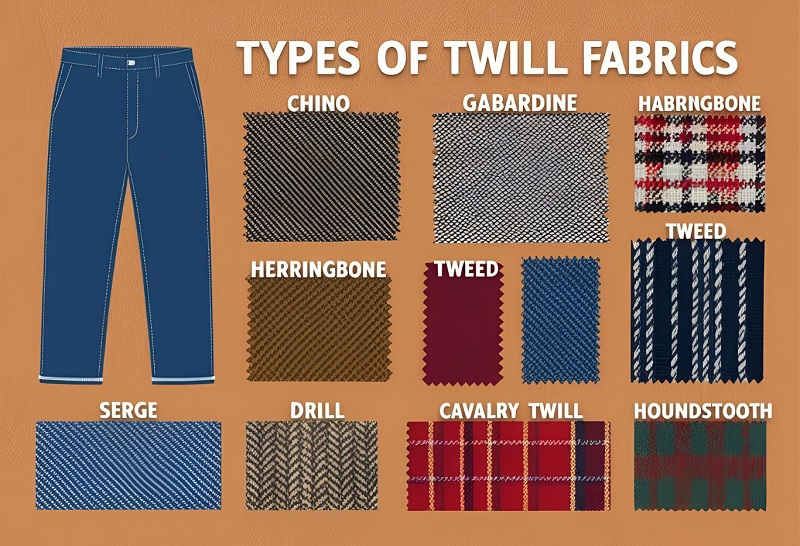
1. Denim
Denim is a heavyweight cotton twill fabric featuring a colored warp thread and a white weft thread, giving it a characteristic faded look over time.
- Applications: Jeans, jackets, overalls, and casual wear.
- Key Features: Durable, breathable, and fade-resistant.
- Fun Fact: The word “denim” comes from the French term “serge de Nîmes,” referring to its origin in Nîmes, France.
2. Chino
Chino is a finer, lightweight cotton twill fabric with a soft finish.
- Applications: Trousers, shorts, military uniforms.
- Key Features: Smooth, slightly glossy, and durable.
- Common Colors: Traditionally khaki, but now available in various shades.
3. Gabardine
Gabardine is a tightly woven twill fabric, traditionally made from wool but also available in cotton and synthetic blends.
- Applications: Suits, overcoats, trench coats, and uniforms.
- Key Features: Water-resistant, durable, and holds its shape well.
- Industries: Fashion, military, and outdoor gear.
4. Herringbone
Herringbone twill features a zigzag pattern, offering a unique texture and visual appeal.
- Applications: Suits, coats, jackets, and upholstery.
- Key Features: Stylish, strong, and versatile.
- Best For: Business attire and high-end fashion.
5. Tweed
Tweed is a rough woolen twill fabric often featuring mixed color flecks.
- Applications: Jackets, coats, caps, and suits.
- Key Features: Warm, textured, and moisture-resistant.
- Traditional Use: Scottish and Irish country wear.
6. Serge
Serge is a smooth twill fabric, often made from wool, known for its diagonal ridges.
- Applications: Military uniforms, suits, and trousers.
- Key Features: Strong, wrinkle-resistant, and durable.
- Historic Significance: Used in naval uniforms for centuries.
7. Drill
Drill is a sturdy cotton twill fabric used in workwear and industrial applications.
- Applications: Uniforms, upholstery, and heavy-duty work clothing.
- Key Features: Tough, breathable, and often dyed.
- Popular Colors: Often seen in white and khaki.
8. Cavalry Twill
Cavalry twill is a firm, double twill fabric with strong diagonal lines.
- Applications: Riding breeches, coats, and military wear.
- Key Features: Heavyweight, smooth, and structured.
- Why It’s Named: Originally developed for cavalry uniforms.
9. Houndstooth
Houndstooth is a twill fabric with a distinctive broken check pattern.
- Applications: Suits, skirts, coats, and jackets.
- Key Features: Bold pattern, stylish, and durable.
- Modern Usage: Frequently used in high-end fashion.
Factors to Consider When Choosing a Twill Fabric
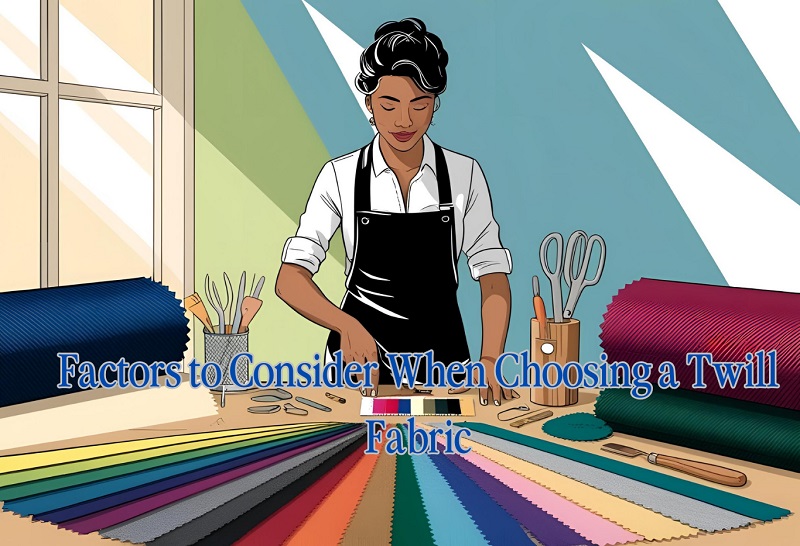
1. Fiber Content
Twill fabrics come in different fibers, such as cotton, wool, polyester, and blends. Cotton twills are breathable, while wool twills provide warmth. Synthetic twills offer wrinkle resistance and cost efficiency.
2. Weave Density
A tighter weave enhances durability and water resistance, while a looser weave increases breathability. For example, gabardine has a tighter weave compared to tweed.
3. Finish and Treatment
Many twill fabrics undergo treatments like water resistance, wrinkle resistance, and dyeing to enhance performance. Denim is often pre-washed for softness, while gabardine is treated for water repellency.
4. Best Uses by Industry
- Fashion: Denim, chino, herringbone, and serge.
- Workwear: Drill, cavalry twill, and gabardine.
- Luxury Textiles: Tweed, houndstooth, and high-end herringbone.
Conclusion
Twill fabrics are versatile, offering durability and aesthetic appeal for various uses. Whether for casual wear, work uniforms, or formal attire, knowing different twill fabric names helps in selecting the right material. These twill fabric names represent a wide range of textures, weights, and finishes suited to specific functions. Understanding twill fabric names also supports better choices in textile manufacturing and design. With their rich history and continued innovation, twill fabric names remain central to both traditional and modern fabric applications.
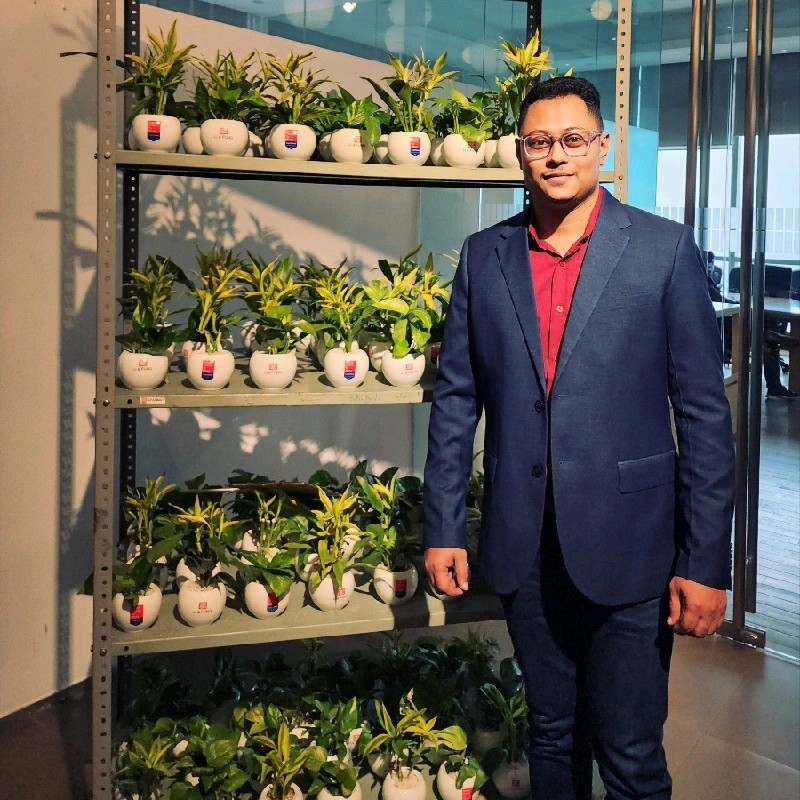
Manager – Fabric Technical and Sourcing/Product Development/ Sustainable Material Management.
I am a B.Sc .-educated Manager of Fabric Sourcing and Technology with extensive experience in the apparel and fashion industry. Passionate about trend analysis, fabric sourcing, and sustainable textile solutions, I thrive in fast-paced environments that demand innovation, adaptability, and leadership.
As a servant leader, I am committed to honesty, transparency, and continuous process improvement. My expertise spans fabric development, product quality management, and supply chain optimization, ensuring exceptional performance across all facets of sourcing and production.
Core Skills & Expertise
✔ Fabric Sourcing & Development – Specialized in regular and sustainable textiles (BCI, Organic, Recycled).✔ Trend Analysis – In-depth understanding of global fashion and fabric trends.✔ Product Development – Expertise in material innovation and process optimization.✔ Quality Management – Strong focus on process control, ensuring high-quality production.✔ Leadership & Problem-Solving – Solution-oriented approach to team management and decision-making.
Technical Proficiency
🖥 Software & Tools:▪ Microsoft Outlook, Excel, Word▪ PLM (Product Lifecycle Management)
🌱 Sustainable & Ethical Practices:▪ Better Cotton Initiative (BCI)▪ Organic & Recycled Fabric Management
Key Strengths
✅ Solution-Focused Leadership – Driving innovation and efficiency in fabric sourcing.✅ Quick Decision-Maker – Adapting to market shifts and production challenges.✅ Team Player with a Positive Attitude – Ensuring collaboration and productivity.✅ Strong Time Management – Meeting deadlines while maintaining quality.
Professional Achievements
🏆 Li & Fung GEM Award – Recognized for fabric sourcing and supply chain management excellence.🏆 Group CEO GEM Award – Honored for outstanding leadership and process innovation.
